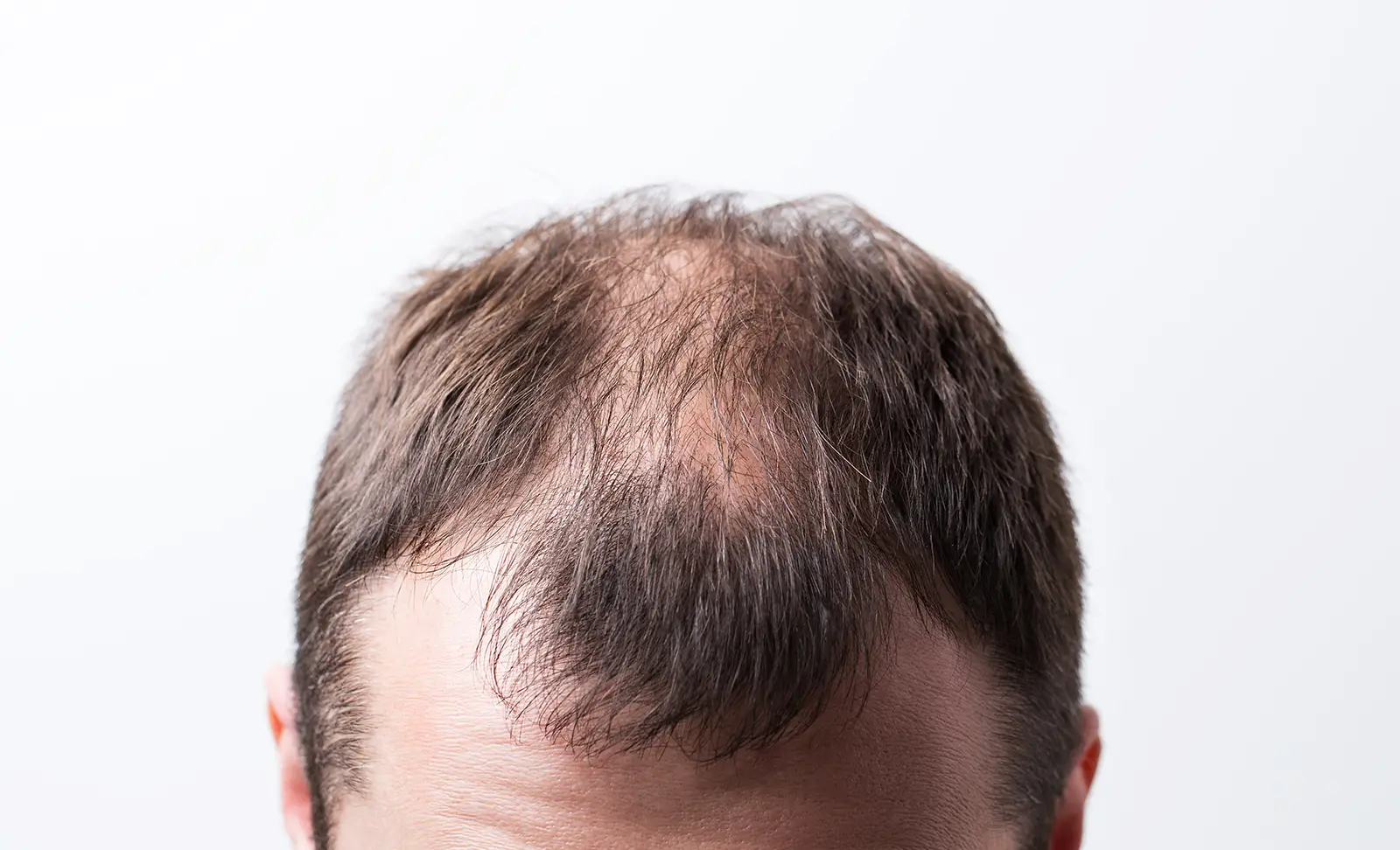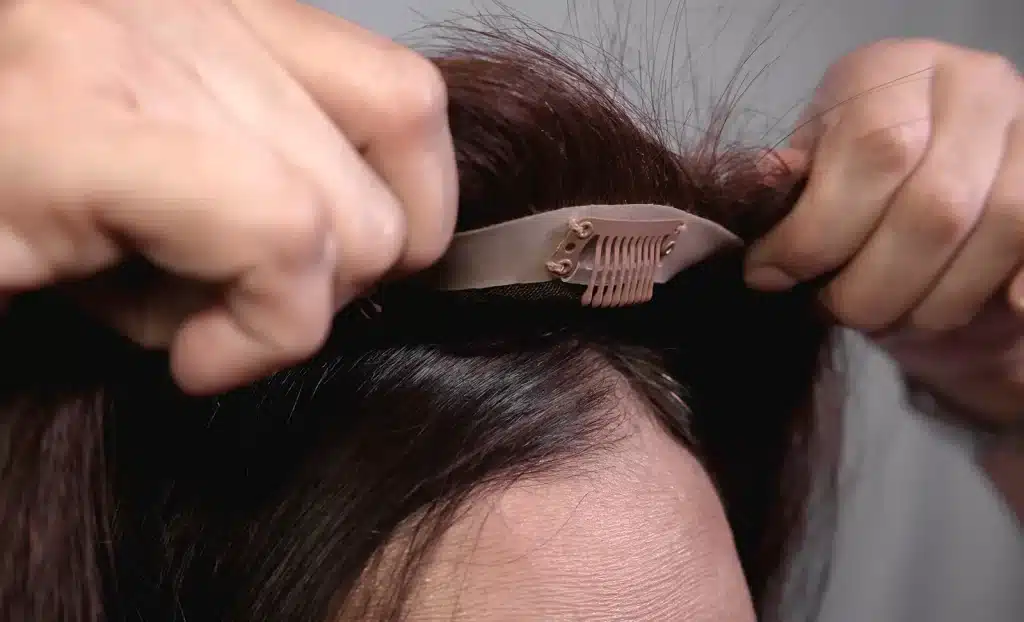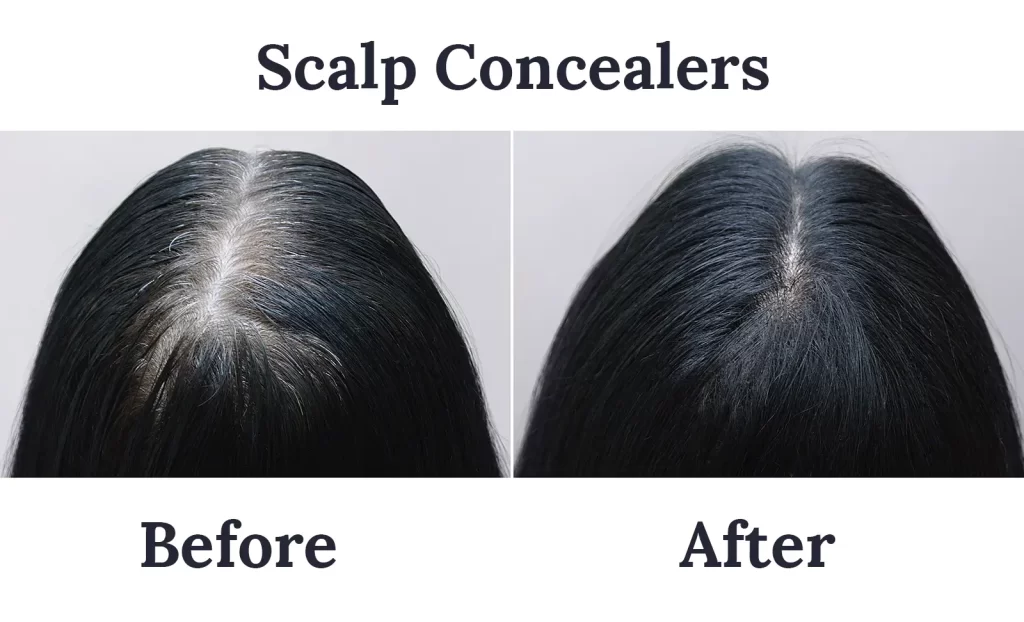Hair loss happens to millions of people all around the world. It’s extremely common, with androgenetic alopecia (the most common form of alopecia) affecting around half of all men and women. [1] That doesn’t make it any easier to deal with, though – once you notice the signs of thinning or falling out hair, you’ll likely want to rush to fix it.
One of the most common places to experience hair loss is at the temples, which often creates an M-shaped hairline if the hair loss is bad enough. Temple hair loss can range from slight thinning in the area to complete baldness. So, what can you do when this happens? In this article, learn all about temple hair loss, from the most common causes to the best hair loss treatment to reverse it. You don’t have to deal with hair loss, especially if it’s affecting your confidence.
What Causes Temple Hair Loss?
To understand how to fix temple hair loss, first, you need to understand what’s causing yours, as the treatment will differ depending on the cause.
Androgenetic Alopecia
Androgenetic alopecia – also known as male and female pattern baldness – is a common form of alopecia that affects a large percentage of the population. It’s common, with most men experiencing some form of hair loss by the time they reach 50. As it’s a genetic condition, there’s not much you can do to prevent it, but there are treatments to slow it down.
Traction Alopecia
Traction alopecia occurs when the hair (and hair follicles) endures consistent pulling, particularly from tight hairstyles such as ponytails and cornrows. It happens because the pull on the follicle causes the hair shaft to loosen. It’s best to stop the tight hairstyle as soon as you notice any form of traction alopecia, as it could worsen over time and become difficult to treat.
Nutritional Deficiencies
Did you know that certain deficiencies can cause temple hair loss? If you miss essential nutrients in your diet, it may be the reason behind not having full, thick hair at your temples. It’s best to speak to a doctor if you suspect a deficiency, as they can run a blood test to check your levels and advise you to take a supplement if necessary.
Telogen Effluvium
Telogen effluvium is a type of shock hair loss that occurs when the body goes through too much metabolic stress. [2] This can happen after hormonal changes, for example, which is why female temple hair loss often occurs during pregnancy. The good news is that telogen effluvium usually reverses on its own once the root cause has been managed, whether that’s through changing a medication or treating hormonal imbalances.
Ways to Hide Temple Hair Loss
If your temple hair loss isn’t too bad, or treatments are not yet having a desirable effect, you may go down the route of hiding your hair loss on the temples.
Wigs
If your hair loss is extensive at the temples, you may consider investing in a wig. There are some real positives to wearing a wig – when worn, you don’t have to worry at all about your hair loss showing through. However, some people have a problem with the maintenance, as you’ll need to take off and reapply the wig routinely.
A New Hairstyle
Sometimes, something as simple as a new hairstyle can be enough to hide temple hair loss. If you constantly wear your hair pulled back in a ponytail, wearing your hair down may cover the temples so it doesn’t look as though you are experiencing any loss of hair at all.
Thickening Sprays
Thickening sprays work well for people with fine, thin hair. A thickening spray can be spritzed onto your hair at the front, giving the appearance of fuller strands, which, in turn, covers up the thinning hair at the temples.
Scalp Concealers
Hair loss at the temples can be easily covered with a scalp concealer. These come in a variety of formulas – some scalp concealers come as a powder, requiring you to shake it onto the area you’re experiencing hair loss for it to conceal properly. Some work better than others, and you’ll have to reapply daily to see the effects last.
Ways to Treat Temple Hair Loss
Most people prefer to tackle temple hair loss by treating it rather than hiding it. That way, they can wear any hairstyle they want and not have to worry about using a wig, hair concealer, or thickening spray before they leave the house. Here are some of the best and most common ways to treat it.
Minoxidil
Minoxidil is an effective hair loss treatment that works on around two-thirds of men, usually those under the age of 40. [3] It’s used for androgenetic alopecia, one of the most common types of hair loss, by reducing the length of the telogen phase. As a result, many people experience lots of hair regrowth after using it, making it a viable temple hair loss treatment. You can get this treatment over the counter, too – you don’t need a prescription from your doctor.
Finasteride/Dutasteride
Finasteride and dutasteride are two very similar drugs that work by blocking the hormone DHT. This works for temple hair loss specifically in men, as DHT is the hormone responsible for male pattern baldness. It’s important to note that there may be some other side effects due to this medication, however – both finasteride and dutasteride can result in a decreased sex drive, impotence, and enlargement of the breast area. Also, these medications can only be prescribed by your doctor.
A FUE Hair Transplant
For hair loss that is quite extensive at the temples, there is a permanent solution: a FUE hair transplant. Hair transplants have become much more effective and high-quality over the years, with people experiencing natural results after the procedure. How it works is quite simple. The surgeon extracts healthy hair follicles from one area of the scalp (an area with healthy hair) and then places those follicles into the thinning area (in this case, the temples). The result is that those follicles then grow over time, giving the patient a full head of hair again.
A hair transplant is more invasive and expensive than medications like minoxidil or finasteride, but they are popular because they require no maintenance, giving you a full head of hair without ever having to worry about it again. Plus, the results are fantastic – just look at our patients gallery to see what the surgeons can achieve.
Should You Get a Hair Transplant for Temple Hair Loss?
If your temple hair loss is getting you down, you may consider a hair transplant. Should you get one? It’s not the easiest decision to make, as there are a few things to consider first.
Do You Have a Healthy Donor Area?
To get a FUE hair transplant, you will need a place for the surgeon to extract from. That will either be the back or sides of your hair. Ideally, you’ll have hair loss at the front but not so much at the back.
How Extensive is Your Hair Loss?
For just a small amount of temple hair thinning, a hair transplant might not be the best route. However, a receding hairline that looks like an M can really defeat your confidence. If it’s that excessive, a hair transplant makes a lot of sense.
Are You a Healthy Adult?
Most people who make good candidates for hair restoration surgery are healthy and over the age of 25. The reason it’s best to be a fully grown adult is that your hair is still going through changes while you are young; it’s a good idea to wait for it to settle before doing something drastic.
What’s Causing Your Hair Loss?
Not all causes of hair loss mean a hair transplant is the best route. For example, hair loss caused by a nutritional deficiency is best treated with a supplement. On the other hand, hair loss from androgenetic alopecia makes a hair transplant an excellent route.
Have You Tried Other Hair Loss Treatments?
A hair transplant for temple hair loss makes more sense when you’ve tried other routes. If treatments such as minoxidil or finasteride do not work, a hair transplant might be the option that restores your locks and confidence. In this situation, it’s more than worth it.
In Summary
Temple hair loss can affect anyone, including both men and women. In fact, it’s extremely common, with a wide range of causes ranging from androgenetic alopecia to telogen effluvium. The good news is you can get a handle on it – it’s all about understanding the cause and then treating it accordingly. There are even ways to effectively hide temple hair loss if you would prefer to do that or if treatments don’t seem to work well for you.
Are you considering a hair transplant? It’s a procedure that could transform your entire life, not just your scalp! At Harley Street Hair Clinic, we offer appointments with our top surgeons through the hair track app. These no-obligation consultations will help you see whether a hair transplant is the best journey for you and your temple hair loss.
Sources:
- https://www.ncbi.nlm.nih.gov/books/NBK430924/#:~:text=Androgenetic%20alopecia%20is%20a%20genetically,scalp%20any%20time%20after%20puberty.
- https://www.ncbi.nlm.nih.gov/books/NBK430848/#:~:text=Telogen%20effluvium%20is%20excessive%20shedding,and%2015%25%20are%20telogen%20hair.
- https://www.webmd.com/beauty/thinning-hair




